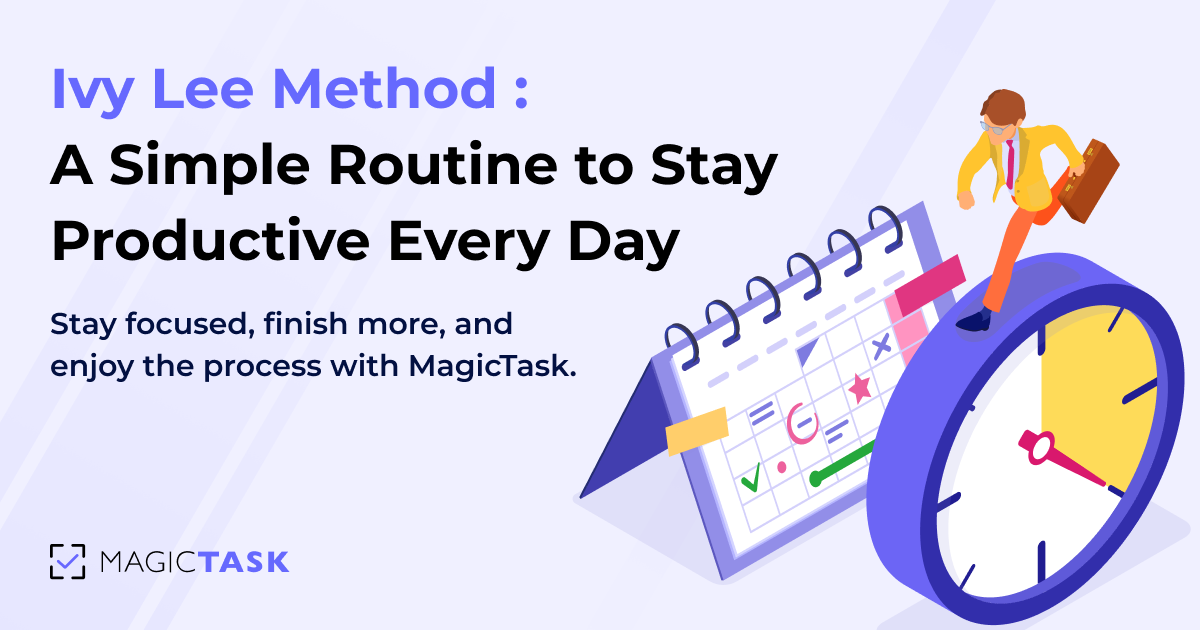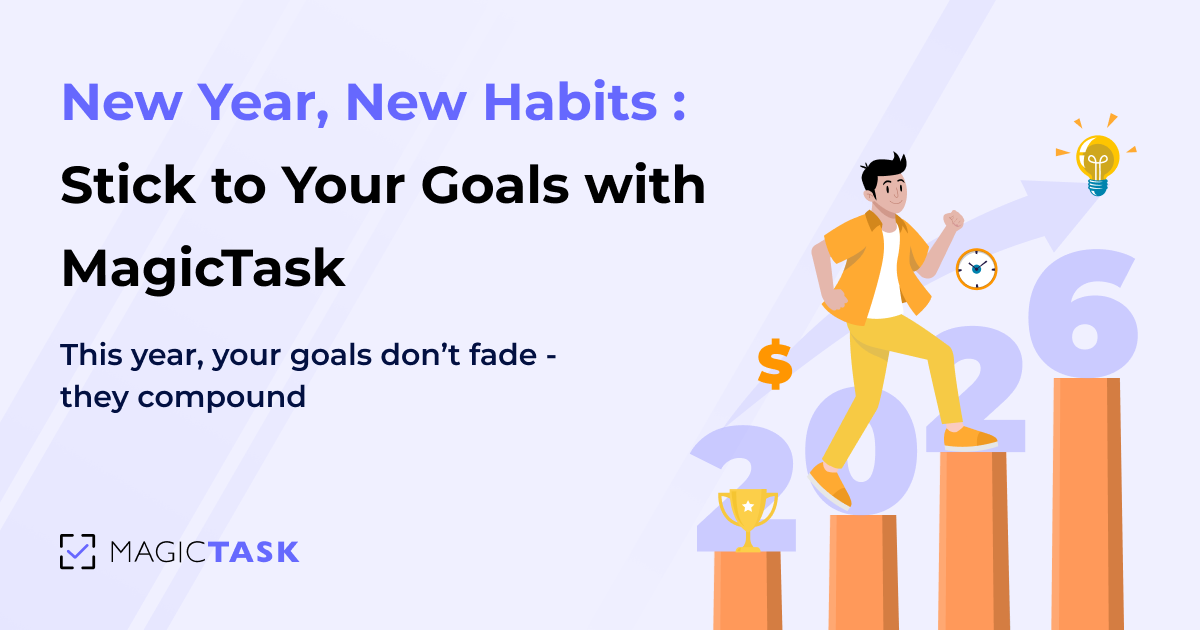No Motivation at Work? Here’s How to Get It Back The Gamer’s Way
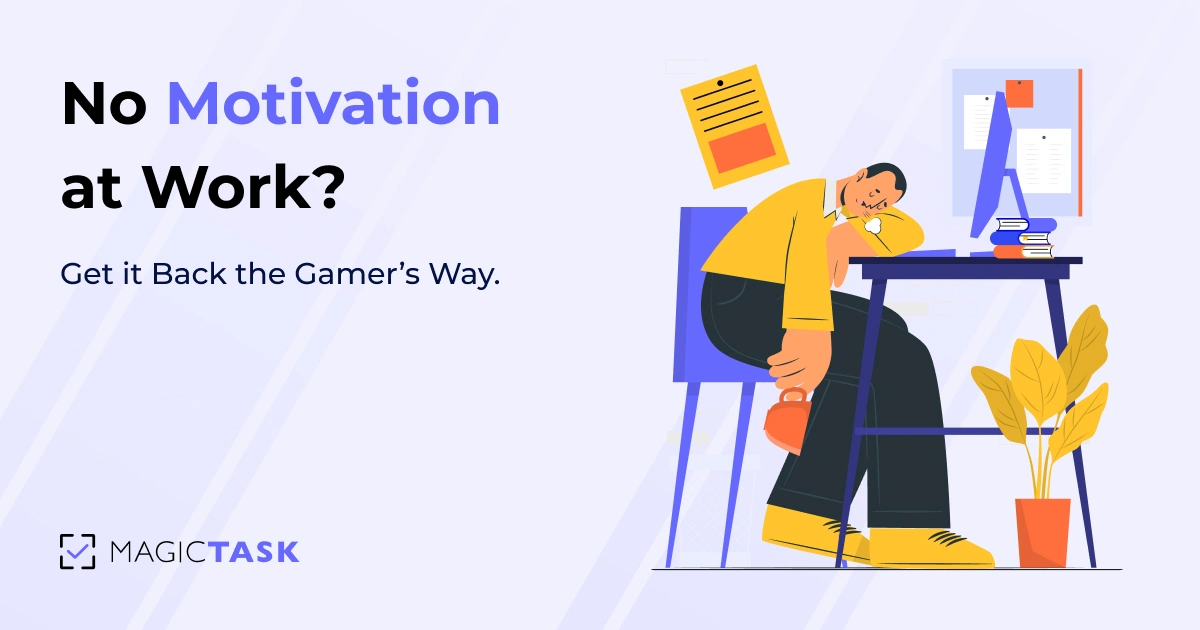
Do you ever find yourself staring blankly at your to-do list, only to close the tab and dive into another internet rabbit hole?
You’ve tried every trick, like color-coded boards, pomodoro timers, even motivational playlists, but by mid-afternoon, you’re back to refreshing Twitter.
If grinding through another checklist feels as appealing as watching paint dry, don’t chalk it up to laziness. It’s a sign your motivation engine needs a tune-up.
Traditional productivity advice of planning harder and pushing through only works until it doesn’t. You end up trapped in a loop of “I’ll complete this tomorrow.”
Before long, you begin to doubt whether you could ever feel that spark at work again.
The secret to reigniting your drive isn’t more discipline, but borrowing from one of the most compelling engagement systems ever invented—video games.
Games excel at pulling you back in with visible rewards. What if you could steal those same mechanics to reboot your drive at work?
In the next few minutes, you’ll learn how to turn your daily grind into a quest worth logging back into for real-world rewards.
Why You Lose Motivation at Work (And Why It’s Not Your Fault)
Before we can find the solution, we need to understand the problem.
Let’s start by explaining motivation.
Motivation is the driving force behind our actions and why we behave in a certain way. It's the internal state that pushes us to engage in goal-directed behaviors.
In your brain, it’s the drive powered by dopamine signals, little chemical nudges that say “yes, keep going” every time you edge closer to something meaningful.
Psychologically, motivation sits at the intersection of expectancy (believing you can succeed), value (caring about the outcome), and timing (seeing the payoff soon enough).
When these three elements align, your brain lights up, and you feel that forward pull.
But at work, those signals often misfire because there’s:
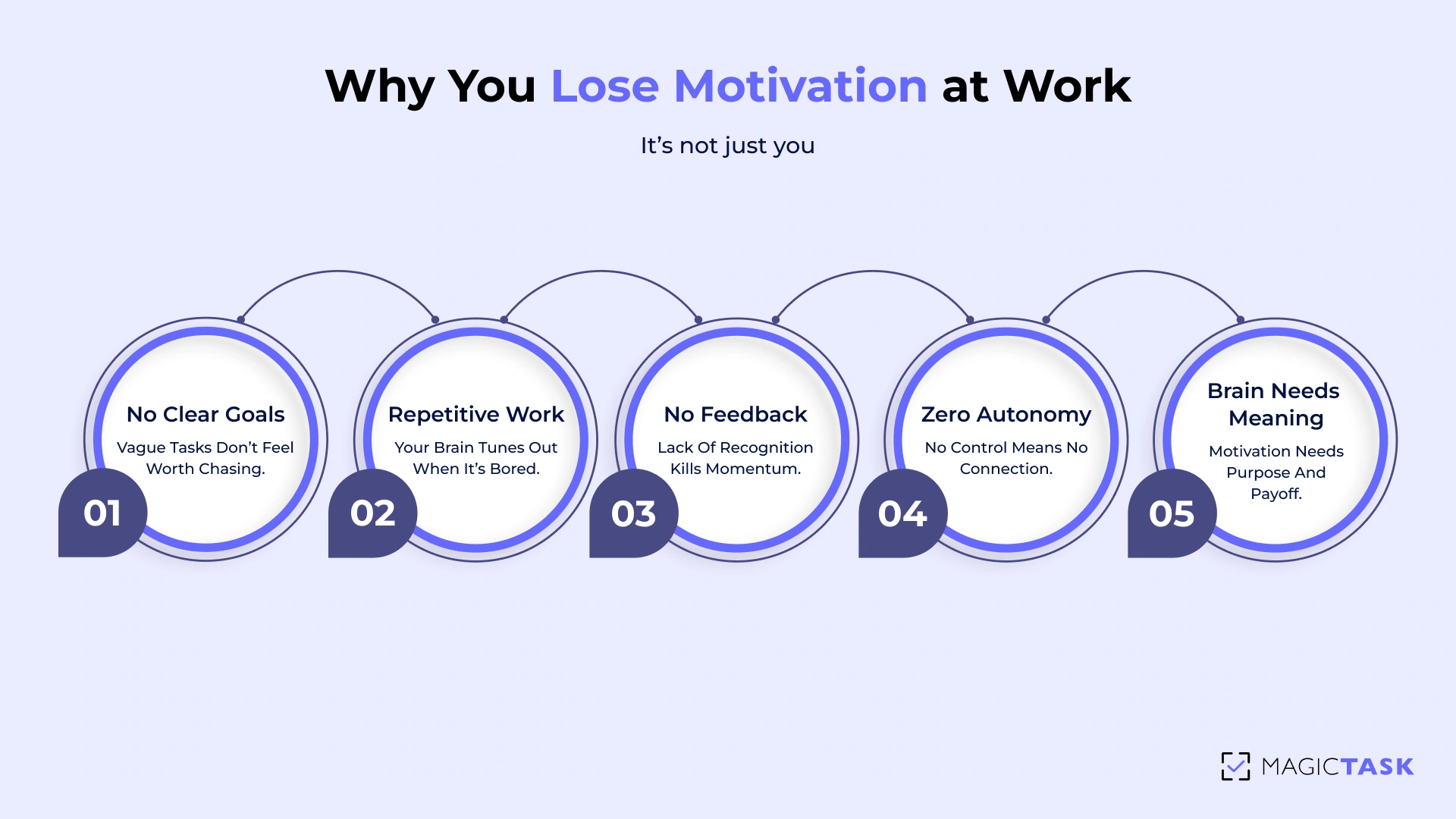
- No Clear Finish Line
Your brain runs on the goal-gradient effect: the closer you are to a target, the harder you’ll push.
Vague objectives like “Improve the website” never feel close enough to get you motivated.
Without crisp, measurable goals, every step feels like a shot in the dark, and your drive slinks away.
- Mind-numbing Repetition
Tasks that loop endlessly, like data entry, routine approvals, and rote reporting, trigger cognitive autopilot.
Your prefrontal cortex checks out and seeks novelty. Without occasional variety or fresh challenges, your brain treats work like background noise, and motivation collapses under monotony.
- Feedback Vacuums
Dopamine neurons crave immediate feedback. Finishing a slide deck at work often earns nothing more than “thanks.”
That delay of recognition starves your reward circuitry. Did you know that employees work 2.7 times better when they are recognized?
- Autonomy Thirst
Self-determination theory suggests that we require a sense of control to remain engaged.
If every decision, from where you work to how you tackle a project, is handed down, your brain resists. Autonomy fuels ownership; without it, you feel like a cog, and motivation tends to disappear.
None of this is your fault. Our brains are wired for clear wins, varied challenges, instant feedback, and self-direction, conditions most workplaces simply don’t provide.
The Gamer’s Way: How Games Keep You Hooked (and What Work Can Learn from That)
With a clear understanding of why motivation often fades, let’s explore how games address these challenges.
1. Clear Objectives and Challenges
In any good game, you never log in wondering what to do next. Your mission appears front and center.
The crystal-clear objective focuses your mind and primes you for action. You know exactly what success looks like and what steps you need to take to get there.
At work, however, we often face broad, vague directives, like “Improve sales,” “Tackle the backlog,” or “Optimize our onboarding process.”
Without a well-defined target, it’s easy to stall, unsure of which first step will move the needle.
To bring the gamer’s clarity to your day job, define your mission: Instead of “Finish report,” specify “Draft the executive summary with three key insights.”
Know when the task is truly done, whether that’s “five slides completed,” “three customer quotes gathered,” or “one A/B test launched.”
Start with quick wins (minor tasks) and build toward bigger ones (medium and large tasks), so you always have a clear next move that feels achievable.
2. Instant Feedback and Reward Loops
Every action triggers a clear response when playing games: hit a target and you hear a satisfying “ping,” see your score climb, or watch an XP bar advance.
That immediate signal tells your brain, “This effort paid off,” reinforces the behavior, and compels you to go for the next hit.
By contrast, at work, feedback often arrives too late to guide our daily choices, such as quarterly performance reviews, end-of-project debriefs, or vague praise in team meetings.
Without real-time confirmation that you’re on the right track, it’s easy to lose momentum and question whether your effort even matters.
To build similar reward loops at work:
- Signal every completion: As soon as a task wraps, capture it visually. Check it off, send a quick status update, or mark it “Done” in your system.
- Tie actions to tangible feedback: Link each finished item to a small, consistent reward, whether a notification, a point tally, or a brief celebratory animation.
- Close the loop quickly: Aim to receive and recognize feedback within minutes of completing the work. The shorter the delay, the stronger the association between action and reward.
3. A Sense of Progress and Leveling Up
Games are built around visible milestones: watch your character gain experience points, see a progress bar inch forward, and eventually hit a new level.
Each milestone feels meaningful because it’s clearly defined and celebrated. You’re not just accumulating abstract numbers.
You can see a tangible bar filling up and know exactly how far you’ve come and how close you're to the next stage.
At work, however, our achievements often disappear into email archives or forgotten meeting notes. Without a clear indicator of cumulative progress, even a day of solid effort can feel like running in place.
Try to break larger goals into smaller segments that correspond to level jumps.
For example, completing three related tasks might unlock a “Project Coordinator” badge, while finishing a whole project earns an “Innovator” title.
4. Personalization (themes, styles, tools)
In every great game, you shape your hero, choosing a look, equipping preferred weapons, and even customizing battle cries.
That level of ownership keeps you invested because the world feels tailored to your tastes and strengths. At work, a one-size-fits-all interface or process can leave you feeling like a cog rather than a player in charge.
Personalization in your productivity toolkit is a quiet signal that you matter.
When you select a theme that resonates, adjust your task view to highlight what you care about most, or integrate the tools you already love, your workspace becomes an extension of your style.
You’re far more likely to dive in when the environment reflects you.
5. Autonomy and Control Over Actions
Top-tier games let you choose your path, whether exploring every corner of the map, tackling optional side-quests, or leveling up skills in the order that suits your playstyle.
That freedom fuels engagement because you’re not just following a script but directing the action.
At work, overly prescriptive processes can feel like handcuffs, stifling creativity and leaving you waiting for someone else to give the green light.
Regaining motivation starts with reclaiming choice. When you decide which task comes next, rather than being handed a rigid, top-down schedule, you’re far more likely to own the outcome. Autonomy also means having clear boundaries.
You know what “done” looks like for each task, and you have the authority to manage your time and tools to achieve that goal.
Equip These 5 Gamer-Backed Fixes to Regain Work Motivation
When your workday feels like a grind, it’s time to borrow a page from your favorite game’s playbook.
Below are five straightforward, battle-tested strategies to help you swap stale routines for forward-driving momentum.
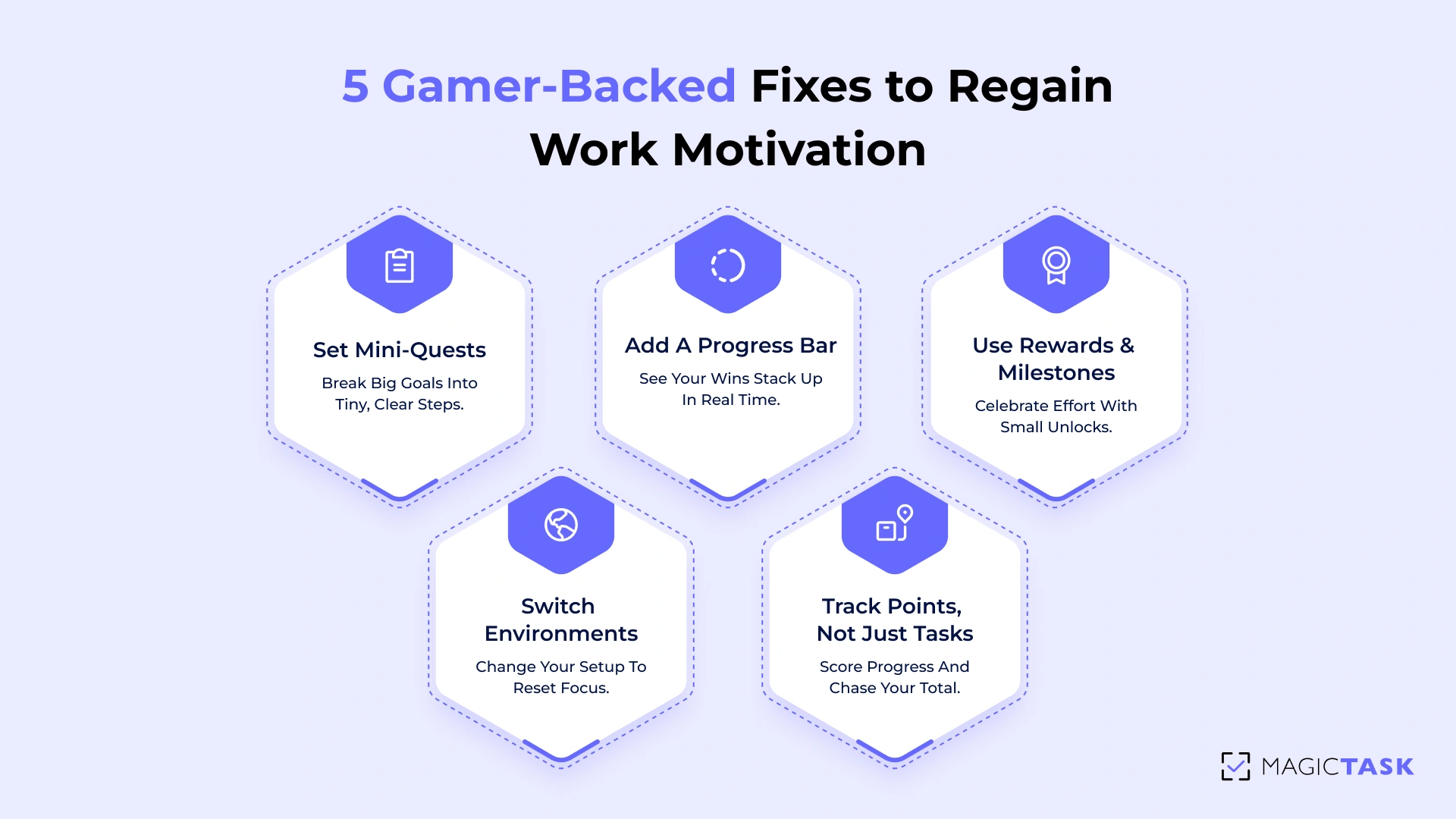
1. Set Mini-Quests, Not Massive Missions
Ambiguity is the enemy of action. When you look at “Launch campaign” on your list, your brain sees a daunting mountain and shuts down.
Instead, carve that mountain into foothills. Identify the very next, smallest thing you can do, like “Draft three customer personas,” “Sketch homepage wireframe,” or “Write two intro paragraphs.”
In MagicTask, assign each step a size—S, M, L, or XL—so you know exactly how much effort you’ve committed. This simple breakdown makes starting trivial tasks feel approachable.
Drag the next quest into your My Focus lane and watch your points rack up as you check off each small victory.
2. Create a Visual Progress Bar for Your Day
Nothing kills momentum like invisible progress. A static to-do list leaves you guessing how much you’ve accomplished; hours blur together, and you lose track of momentum.
A visible progress bar changes all that: every checkmark turns into a slice of a pie or a bar graph segment, showing you exactly how far you’ve come.
Suddenly, your morning sprint from zero to 20 percent feels like absolute forward motion, and the jump from 75 to 100 percent by day’s end becomes a clear target you’re driven to hit.
With MagicTask’s live XP bar and point tally, every completed task triggers an animation, updates your score, and moves the bar ever closer to the next level.
That visual momentum, seeing your daily progress bar fill, releases tiny dopamine hits each time you hit “Done.”
You’ll find yourself leaning in to rack up just one more small victory before lunch.
3. Use Rewards and Milestones to Stay Engaged
Human brains respond to reward. A quick “Well done” moment punctuates effort with pleasure, and that’s exactly what keeps you coming back for more.
MagicTask seamlessly integrates those rewards into your workflow.
As you accumulate points, you unlock new UI themes and animations that refresh your workspace. Pair three key milestones, say, finishing your outline, finalizing the slide deck, and resolving the most challenging client issue, with the reveal of a fresh theme.
That instant visual treat reinforces your achievement, making each milestone feel like a significant step up in your productivity game.
4. Switch Environments Like a Game Map
Staring at the same dreary spreadsheet or inbox day after day breeds mental fatigue. Your focus plateaus, and every task feels like just another grind.
To break that pattern, you need deliberate “environment switches” that signal to your brain: it’s time for a new mode.
MagicTask makes refreshing simple.
Switch themes mid-day to signal a new focus session, or collapse everything but your current task to eliminate distractions at a glance.
Stand up, stretch, and maybe move to a different corner of your office for a quick physical reset. Each visual and physical tweak resets your attention, like dropping into a new map in your favorite game.
5. Track Points, Not Just Tasks
Shifting from checkmarks to point values changes your mindset from “Did I finish?” to “How many points did I earn?” Every small win becomes a chance to score.
Rather than counting only completed tasks, tally the “points” you earn by finishing them.
In MagicTask, each task size corresponds to a point value, so your daily total becomes a quick measure of effort and achievement.
Focusing on accumulating points shifts your mindset from endless planning to measurable accomplishment, making every checkmark an invitation to keep going.
Bonus: Turn Procrastination into Play
You don’t need to wait for perfect conditions to tackle your most demanding tasks—you can inject a little game magic even into the most daunting to-dos.
Here’s how to turn resistance into excitement:
1. Boss Battles for High-Resistance Tasks
Think of that 10-page report or complex spreadsheet as your raid boss: big, intimidating, but conquerable. Break it into phases—outline the sections, draft each part, and then polish.
In MagicTask, label each phase as an “XL” or “L” task, and treat the final polish as the climactic showdown.
Each completed phase earns you points toward a “boss-defeated” badge, making progress visible and rewarding each milestone.
2. Power-Ups to Supercharge Your Focus
Like a health potion or speed boost in a game, real-world power-ups can prime your brain for action. Queue up your favorite productivity playlist, set a 10-minute countdown, or sip a strong cup of coffee before diving in.
MagicTask’s theme-switching can serve as your in-game power-up animation—trigger a “Turbo Mode” theme when you start a critical task so your workspace looks (and feels) energized.
3. The Two-Minute Rule as a Warm-Up Move
In every RPG you ever played, the first step is always the easiest: pick up your sword and step into the village. Apply that same trick to work.
If something takes less than two minutes, like replying to an email, clearing your desktop, or jotting down a quick idea, do it immediately.
MagicTask rewards these tiny victories with immediate points, creating a chain reaction.
Two-minute tasks clear mental clutter, and those early dopamine hits fuel you straight into longer, higher-value quests.
By reframing your workday through these gamer-inspired lenses, even the most tedious tasks become part of a larger, rewarding adventure.
Procrastination doesn't stand a chance when you see every challenge as a quest, every break as a strategic pause, and every quick win as XP earned.
Closing: Time to Respawn Your Motivation
Losing drive at work doesn’t mean you’ve failed.
It means your routine needs a reset.
By borrowing game design principles, like clear objectives, instant feedback, and meaningful rewards, you can reboot your drive and make every workday feel like a series of winnable quests.
Think of MagicTask as your productivity console.
It gives you that satisfying loop of setting a quest, earning XP, and unlocking fresh themes when you complete it. No more wandering through endless to-dos or waiting for “someday.”
Instead, you’ll see your progress in real time, celebrate each small victory, and stay fueled for the challenges ahead.
Equip your first theme, assign a quest, and start leveling up today, because the best way to find your motivation is to play the game.


